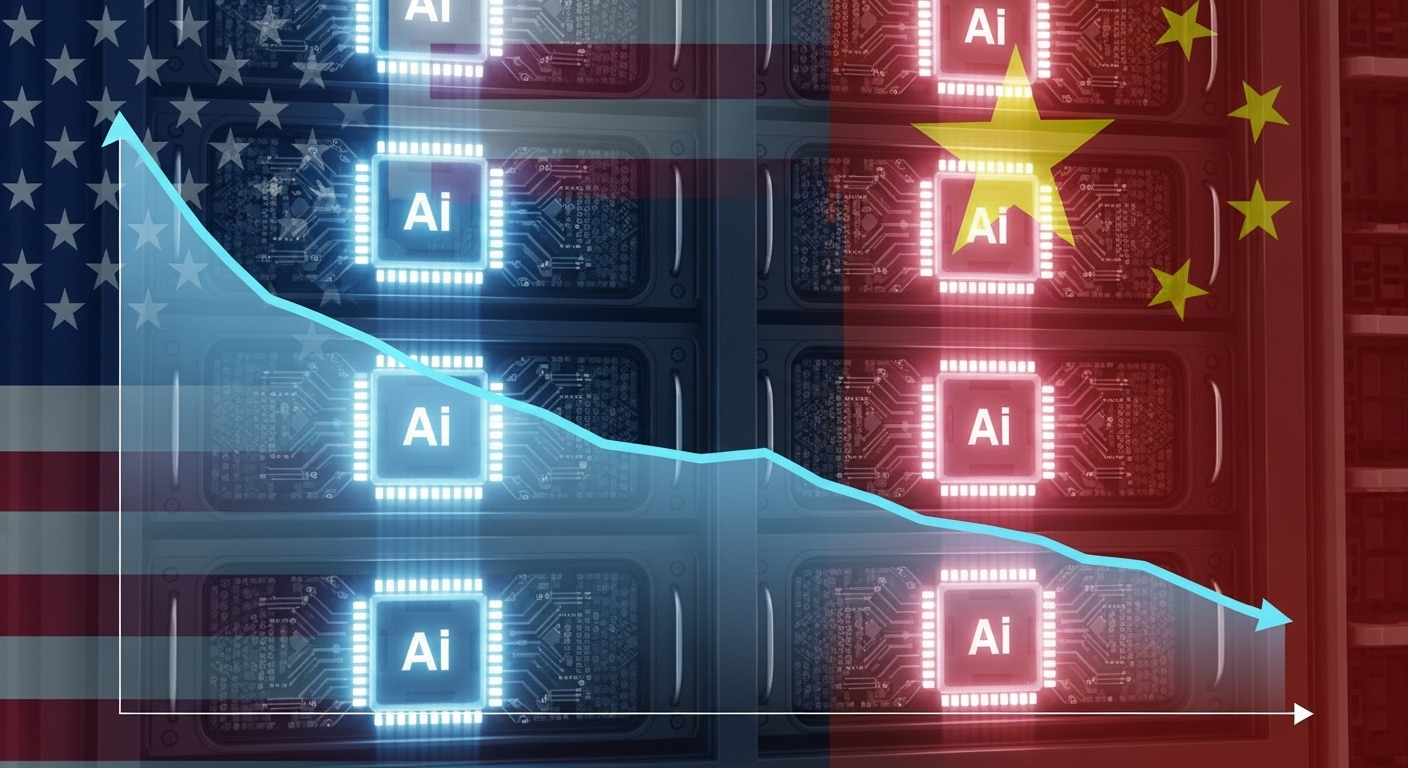Crucial Deep Dive: Why Nvidia Shares Slide as AI Chip Growth Decelerates
The tech world held its breath this week as Nvidia, the undisputed titan of artificial intelligence (AI) chips, saw its **Nvidia shares slide** following its Q2 2026 earnings report. While the semiconductor giant still posted impressive year-over-year growth, market analysts and investors quickly homed in on specific metrics signaling a deceleration in its previously explosive AI chip growth.
This isn’t just about one company’s stock performance. Nvidia has become a crucial bellwether for the entire AI industry, reflecting broader shifts in technological development, investment sentiment, and the complex geopolitical landscape. To truly understand the implications, we must move beyond the immediate headlines and delve into the nuanced factors at play.
Key Takeaways:
- Nvidia’s Q2 2026 earnings showed strong year-over-year growth but a noticeable sequential deceleration in data center revenue, primarily due to the absence of H20 chip sales to China.
- Aggressive US export restrictions on advanced AI chips, particularly the H20 to China, have significantly impacted Nvidia’s short-term revenue and introduced geopolitical uncertainty.
- Hyperscalers like Google and Amazon are increasingly developing custom AI chips, posing a long-term threat to Nvidia’s market share in specific, large-scale AI workloads.
- Nvidia’s robust CUDA software ecosystem and expansion into full-stack solutions and “Sovereign AI” represent vital new revenue streams designed to mitigate hardware growth deceleration.
- Concerns about an “AI bubble” are growing, with Nvidia’s performance acting as a key indicator of market sentiment, drawing parallels to historical tech booms.
- Investors need a diversified strategy, considering Nvidia’s long-term dominance in AI innovation against short-term market volatility and evolving competitive landscapes.
The Recent Nvidia Shares Slide: A Bellwether Moment
On August 27, 2025, Nvidia reported its financial results for the second quarter of fiscal year 2026. The company announced a robust total revenue of $46.7 billion, marking a substantial 56% increase year-over-year. Data Center revenue, the core driver of Nvidia’s AI dominance, also surged by 56% compared to the previous year, reaching $41.1 billion.
However, beneath these impressive figures, a critical detail caught the market’s attention: data center revenue grew only 5% sequentially from Q1 2026. Furthermore, Nvidia’s Q3 2026 revenue guidance of $54.0 billion, while still indicating strong year-over-year growth (54%), implicitly factored in no H20 shipments to China. This omission, coupled with the sequential slowdown, fueled concerns that **Nvidia shares slide** was justified by underlying challenges to its explosive growth trajectory.
Deceleration Decoded: Unpacking the Nuances
Data Center Growth: A Sequential and Historical Lens
While a 56% year-over-year increase in data center revenue is exceptional for a company of Nvidia’s scale, the 5% sequential growth from Q1 to Q2 2026 represents a noticeable shift. For years, Nvidia’s data center segment had been a story of relentless, often double-digit, quarterly expansion. Investors, accustomed to hyper-growth, interpreted this as a significant deceleration, leading to a negative market reaction despite beating overall revenue estimates.
Historically, market darlings riding transformative waves often face increased scrutiny when their growth rates, no matter how strong, begin to normalize. This current phase, while far from a decline, indicates a maturing market and mounting external pressures that were less prominent in previous quarters.
The Weight of US Export Restrictions: The H20 Saga
A primary driver for the data center deceleration and investor anxiety is the complex web of US export restrictions impacting Nvidia’s ability to sell advanced AI chips to China. In April 2025, the US government significantly tightened these controls, requiring licenses for the export of Nvidia’s H20 chip—a modified GPU specifically designed to comply with previous, less stringent regulations for the Chinese market.
This ban resulted in a substantial financial hit for Nvidia, including a $4.5 billion charge in Q1 2025 and a projected $5.5 billion impact for the fiscal first quarter. Although the Trump administration later eased some restrictions in July-August 2025, allowing H20 sales to resume under license following discussions with CEO Jensen Huang, the uncertainty remains. Nvidia’s Q3 2026 outlook still doesn’t assume any H20 shipments to China, indicating ongoing volatility in this crucial market.
China represents a massive AI infrastructure market, estimated to expand at 50% annually, potentially a $50 billion opportunity. The restrictions not only curb Nvidia’s immediate revenue but also accelerate China’s drive for technological independence, fostering domestic alternatives like Huawei’s Ascend 910C. There’s even a proposed 15% revenue-sharing fee with the US government for H20 sales, adding another layer of complexity.

The Rise of Custom AI Chips: Challenging Dominance?
Beyond geopolitical hurdles, Nvidia faces a growing threat from its largest customers: hyperscalers developing their own custom AI chips. Tech giants like Google (with its Tensor Processing Units or TPUs), Amazon (Trainium and Inferentia), Microsoft (Maia), and Meta (MTIA) are investing heavily in proprietary silicon.
Their motivation is clear: custom chips offer significant advantages in cost, power efficiency, and tighter integration with their specific cloud ecosystems and AI workloads. While Nvidia’s general-purpose GPUs excel in flexibility, these domain-specific architectures are tailored for hyperscale environments, potentially eroding Nvidia’s market share for highly specialized tasks within these tech behemoths. Nvidia is not sitting idly, however; it has introduced offerings like NVLink Fusion to build semi-custom AI infrastructure with these hyperscalers, attempting to keep itself at the center of their evolving AI strategies. This marks a strategic shift where Nvidia aims to partner rather than exclusively supply off-the-shelf solutions.
Nvidia’s Strategic Pivot: Beyond Core Hardware
The Indispensable CUDA Ecosystem
Nvidia’s enduring competitive advantage isn’t just its hardware; it’s the CUDA parallel computing platform. This proprietary software ecosystem has created a powerful lock-in effect, making it incredibly difficult for developers and organizations to switch to rival chip architectures without significant re-engineering and cost. CUDA provides a unified, high-performance environment that leverages Nvidia’s GPUs for everything from AI training to scientific simulations.
This software moat ensures that even if competitors introduce compelling hardware, the investment in CUDA-optimized codebases keeps customers tethered to Nvidia. The company’s earnings from CUDA are not limited to direct sales and licensing; it forms the backbone of its platform value.
New Revenue Streams and Software Platforms
To mitigate the impact of hardware growth deceleration and increasing competition, Nvidia is actively diversifying its revenue streams. Its “Sovereign AI” initiative, focused on providing AI hardware and software to governments globally (outside of China), is projected to bring in US$20 billion this year alone. This strategy not only diversifies revenue but also aligns with US policy goals.
Beyond its core GPU sales, Nvidia is expanding into comprehensive solutions, selling entire computing systems like NVL72 racks and positioning itself as a full data center solutions provider. Software platforms like Omniverse and new AI Enterprise libraries and SDKs for physical AI development further showcase Nvidia’s push into higher-margin software and services. These ventures aim to create recurring revenue and deepen customer engagement, reducing sole reliance on chip sales.
Is the AI Market a Bubble? Historical Echoes and Present Indicators
The meteoric rise of AI stocks, with Nvidia at its forefront, has inevitably sparked discussions about an “AI bubble.” Comparisons to the dot-com bubble of the late 1990s and early 2000s are frequent, with market observers pointing to soaring valuations, significant speculative investment, and the rapid deployment of infrastructure that might outpace immediate demand.
The concentration of wealth in a few “Magnificent Seven” tech stocks, including Nvidia, currently makes up a substantial portion of the S&P 500, a level of market concentration that historically signals heightened risk. While AI’s long-term potential is undeniable, questions arise about whether current valuations are detached from clear revenue models or if this is merely a “temporary correction” in a transformative technological revolution. Nvidia’s recent sequential deceleration, therefore, serves as a crucial indicator, potentially signaling either the early stages of a market re-evaluation or simply a hiccup in a prolonged growth story.

The Global AI Chessboard: Diversifying Beyond US-China
Recognizing the volatility of the US-China trade relationship, Nvidia is strategically expanding its presence in other geographical markets. Europe is a significant focus, with initiatives like the expansion of DGX Cloud Lepton connecting developers to Nvidia’s global compute ecosystem. The company is also collaborating on advanced AI supercomputers across the US, Germany, the UK, and Japan, demonstrating a commitment to global partnerships.
Perhaps most notably, Nvidia has secured a landmark $600 billion deal with Saudi Arabia’s HUMAIN, deploying 18,000 Blackwell GB300 chips for a 500-megawatt AI factory. This move not only diversifies Nvidia’s revenue streams but also aligns with US policy objectives of exporting advanced technology to allies. Model builders across Europe and the Middle East are also optimizing large language models with Nvidia Nemotron, underscoring the company’s broad international reach and strategic diversification.
Scenario Analysis: Navigating Nvidia’s Future Crossroads
Nvidia’s future performance hinges on several key variables. Here, we outline a few potential scenarios:
- Scenario A: Controlled Growth Amidst Geopolitical Easing. If US-China tensions stabilize and H20 export licenses become more predictable, Nvidia could see a rebound in its China revenue (potentially $2-5 billion in Q3 alone). Combined with continued demand from other markets and hyperscalers, this scenario suggests strong but more measured growth as the AI market matures and competitors emerge.
- Scenario B: Intensified Headwinds. Should export restrictions tighten further, or China’s domestic chip industry rapidly advance (e.g., Huawei’s Ascend series), Nvidia could face prolonged revenue suppression in one of the world’s largest markets. Aggressive custom chip development by hyperscalers could also accelerate, further carving out Nvidia’s share in specialized workloads. This would put more pressure on software and diversified markets.
- Scenario C: Software and Ecosystem Dominance. Nvidia successfully leverages its CUDA ecosystem and full-stack solutions to maintain its lead, even if hardware sales growth decelerates. By embedding itself deeper into enterprise AI, robotics, and automotive sectors through software, platforms, and “Sovereign AI” initiatives, Nvidia could transition from a pure hardware leader to a comprehensive AI solutions provider, securing long-term, high-margin revenue streams.
Actionable Investment Advice for Diverse Portfolios
The current market dynamics surrounding Nvidia require a thoughtful approach for investors with varying risk profiles.
- For Long-Term Investors: Nvidia remains a dominant force in a transformative industry. However, its high valuation means future growth is already priced in to a significant extent. Diversification is key. Consider holding Nvidia as a core, long-term position, but ensure it doesn’t represent an outsized portion of your overall portfolio. Rebalance if necessary. Look for opportunities during market dips, but be prepared for volatility. Many on Reddit and Quora emphasize that Nvidia is a long-term play, not a short-term trade.
- For Short-Term Traders: Nvidia’s stock is known for its volatility, particularly around earnings reports. While some traders may see the recent slide as a “buy the dip” opportunity, it comes with inherent risks given the ongoing geopolitical and competitive uncertainties. Short-term plays require careful technical analysis, strict risk management, and a close eye on news related to trade policies and competitive announcements.
- For Growth Investors: While Nvidia’s growth rate is decelerating from its peak, it is still substantial (50%+ YoY). Focus on the company’s strategic pivots: the strength of the CUDA ecosystem, expansion into software and full-stack solutions, and diversification into new geographic markets like the Middle East. These factors could fuel sustained, albeit slower, growth. Evaluate Nvidia against other high-growth tech stocks, paying close attention to its P/E ratio relative to its adjusted growth expectations.
Regardless of your investment style, understand the inherent risks: geopolitical instability (especially regarding Taiwan, where many chips are manufactured), intense competition from both rivals and customers, and the potential for a broader tech market correction. A well-diversified portfolio, including investments outside of the semiconductor sector, is always a prudent strategy. Understanding different investment strategies can help tailor your approach.
The recent **Nvidia shares slide** isn’t a death knell but a crucial juncture. It highlights the complexities of operating at the bleeding edge of technology and geopolitics. As the AI industry continues its rapid evolution, Nvidia’s ability to innovate, adapt, and navigate these challenges will determine its trajectory as an industry leader.
For further insights into broader market trends, consider reading our article on The Future of AI Computing, or explore The Semiconductor Industry Outlook for a wider perspective on chip manufacturing and innovation.
FAQ
Q: Why did Nvidia shares slide recently?
A: Nvidia shares slid following its Q2 2026 earnings report due to a perceived deceleration in its data center revenue growth, specifically a 5% sequential increase compared to previous quarters of hyper-growth. This was largely influenced by the absence of H20 chip sales to China due to ongoing US export restrictions, which also impacted its Q3 2026 outlook.
Q: What are the US export restrictions affecting Nvidia’s H20 chip to China?
A: The US government imposed strict licensing requirements in April 2025 on Nvidia’s H20 chip, which was designed for the Chinese market under previous regulations. This effectively banned sales, leading to significant revenue losses for Nvidia. While some restrictions were eased in July-August 2025, allowing sales under license, Nvidia’s current outlook still excludes these shipments due to persistent uncertainty and a proposed 15% revenue-sharing fee.
Q: How do custom chips from hyperscalers like Google and Amazon impact Nvidia?
A: Hyperscalers such as Google (TPUs), Amazon (Trainium/Inferentia), and Microsoft (Maia) are developing custom AI chips to reduce their reliance on Nvidia, improve cost-efficiency, and optimize performance for their specific AI workloads. This poses a long-term threat to Nvidia’s market share in the high-volume data center segment, as these companies seek greater control over their AI infrastructure.
Q: Is Nvidia developing new revenue streams beyond hardware?
A: Yes, Nvidia is strategically expanding beyond hardware. Key initiatives include strengthening its CUDA software ecosystem, offering full-stack AI solutions (hardware and software), and pursuing its “Sovereign AI” strategy to sell AI infrastructure to governments outside China, projected to bring in US$20 billion this year. These software and platform offerings are crucial for mitigating hardware growth deceleration.
Q: What are the concerns about an ‘AI bubble,’ and how does Nvidia fit in?
A: Concerns about an ‘AI bubble’ stem from soaring valuations, speculative investments, and the rapid pace of infrastructure build-out that may outstrip actual demand, drawing parallels to the dot-com era. Nvidia, as a leading AI beneficiary, is central to this discussion. Its recent stock slide is seen by some as an early indicator of market re-evaluation, while others view it as a temporary correction in a robust, growing market.
Q: What investment advice is there for Nvidia stock after its recent slide?
A: For long-term investors, Nvidia remains a strong holding, but diversification is essential given its high valuation and market volatility. Short-term traders should exercise caution due to geopolitical risks and competitive pressures. Growth investors should focus on Nvidia’s strategic pivots into software and new markets. Regardless, risk management and a balanced portfolio are paramount.
BONUS QUERIES FOR USA
Q1. Is NVIDIA (NVDA) a good stock to buy?
A1. Many investors see NVIDIA as a leader in AI and graphics technology, making it an attractive long-term option. However, it’s important to evaluate market conditions, competition, and your personal investment goals before buying.
Q2. Should I buy NVIDIA stock now?
A2. Timing depends on market trends and earnings reports. Some analysts believe NVIDIA’s AI chip dominance makes it a strong buy, while others suggest waiting for a pullback.
Q3. Is NVIDIA a good long-term investment?
A3. NVIDIA has a strong track record of innovation in AI, GPUs, and data centers. Long-term growth potential looks solid, though competition from companies like AMD and Broadcom is increasing.
Q4. Should I sell NVIDIA stock?
A4. Selling depends on your portfolio strategy. If you’ve reached profit targets or are worried about short-term volatility, trimming some holdings might make sense. Otherwise, long-term holders often stay invested.
Q5. What is NVIDIA’s stock outlook for 2025 and beyond?
A5. Analysts predict continued demand for AI and data center chips, though growth may slow compared to past years. Price targets vary, but most forecasts remain positive for 2025.
Q6. What is NVIDIA’s stock price prediction for 2030?
A6. Some projections suggest NVIDIA could grow significantly by 2030 if AI adoption continues. However, predictions that far ahead are speculative and should be viewed cautiously.
Q7. How does Broadcom’s rise affect NVIDIA?
A7. Broadcom is gaining attention in custom AI chips, which may reduce NVIDIA’s dominance. Still, NVIDIA remains a leader in GPUs and AI software ecosystems.
Q8. Is NVIDIA still worth buying after recent pullbacks?
A8. Pullbacks often present buying opportunities for long-term investors. However, short-term traders should watch for volatility around earnings and AI market shifts.
Q9. What are analysts saying about NVDA stock today?
A9. Opinions are mixed: some analysts recommend buying due to strong AI demand, while others warn of overvaluation. Checking recent financial reports and guidance is crucial.
Q10. Should I invest in NVIDIA or explore alternatives?
A10. NVIDIA is a major AI play, but diversification across other tech leaders (like AMD, Broadcom, or AI-focused ETFs) may reduce risk while keeping AI exposure.
















Add a Comment